G’day! How is it going? I bet you’ve heard of the Taj Mahal before, I guess pretty much everyone in the world has already heard of it. It is the most visited site in India by far, according to the Indian government the Taj Mahal monument received almost 33 million visitors in between 2021 and 2022. The second most visited monument in this country, the Red Fort, received 13 million people in the same period. The difference is just gigantic and even if you suppose it is due to some visitors that only go to India to strictly see the Taj Mahal and leave, it is still a huge difference.
This makes us wonder what is so fascinating about this building? Is it because of the love history in the background? Is it because of its importance to the local history? Well, I would guess it is due to something else. Human beings are usually extremely attracted to geometrical symmetry and the Taj Mahal has it everywhere. From the building facades to the site plan, everything is very symmetrical and it also carries the Golden Ratio measurement in its proportions. Impressive features that make nowadays buildings look somehow lacking beauty.

The perfectly symmetrical features of the Taj Mahal and its surroundings. Source: https://www.re-thinkingthefuture.com/designing-for-typologies/a7376-an-overview-of-axial-symmetry-architecture/

The symmetrical site plan of the Taj Mahal showing all its buildings and gardens following geometrical patterns. Source: https://www.slideshare.net/AnkitSinha22/taj-mahal-architecture
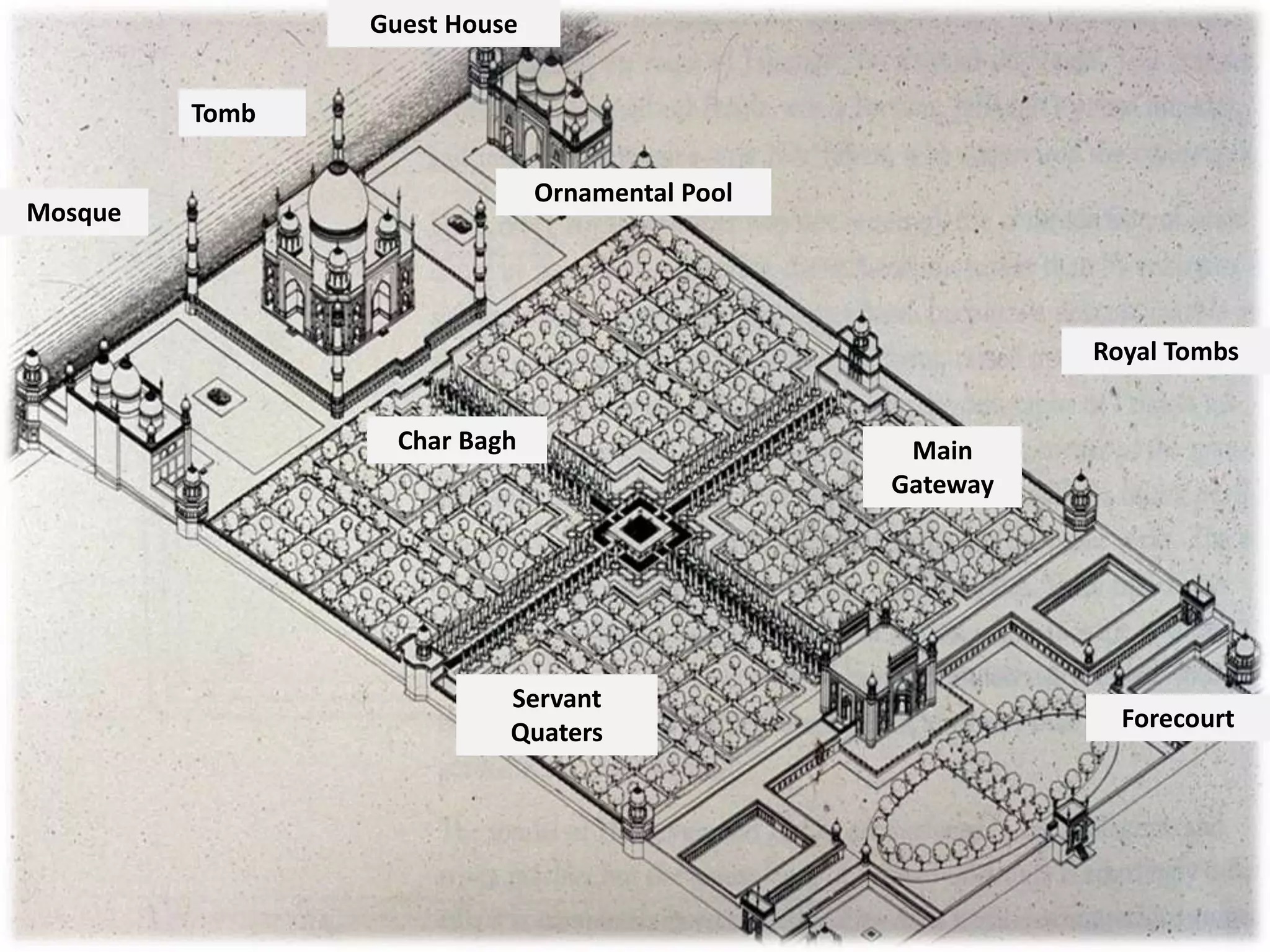
The symmetrical site plan of the Taj Mahal on 3D view showing all its buildings and gardens following geometrical patterns. Source: https://www.slideshare.net/AnkitSinha22/taj-mahal-architecture
Historical Context
Let’s get to the historical facts. Nestled on the banks of the Yamuna River in Agra, India, the Taj Mahal stands as a testament to timeless love and exquisite architectural mastery. Built by the Mughal emperor Shah Jahan in memory of his beloved wife Mumtaz Mahal, this iconic structure has captured the hearts and imaginations of millions around the world. Beyond its romantic narrative, the Taj Mahal is a masterpiece of architectural design, blending elements from various cultures to create a truly unique and awe-inspiring monument.
To truly appreciate the architectural brilliance of the Taj Mahal, one must delve into its historical context. Commissioned in 1632 and completed in 1653, the Taj Mahal represents the pinnacle of Mughal architecture during the reign of Shah Jahan. The Mughals, who ruled much of the Indian subcontinent from the 16th to the 19th centuries, were known for their grandiose structures and meticulous attention to detail.
That’s the official history of the Taj Mahal. However, if you do a quick research on the internet you will find researchers pointing to some sort of geometrical relation (the Sacred Geometry presence) with other buildings supposed to be part of the Tartary Empire (Tartaria) back on the time (13th-19th centuries), an empire that perhaps was much larger than it is actually portrayed and from which we have very limited official information (Video analyzing the Taj Mahal: Tartarian Zephyr). I would recommend a look at the Tartarian Truthers YouTube Channel as they have hundreds of videos detailing their investigations on ‘Tartaria”. And it is very intriguing!
One of our previous blog posts also presents buildings supposedly part of the lost ‘Tartarian Empire’ – Australian 19th Century Churches and Cathedrals. It is important to notice that even though this theme is treated as a conspiracy, there are several historians around the world that investigate it in a very serious way. Also, the CIA recently disclosed documents about the theme on the internet where they show how the topic was taken away from academic books after the Soviet Union Cultural Revolution.
Architectural Elements
At first glance, the Taj Mahal appears to be just a massive symmetrical masterpiece (it actually has a big scale for human standards!), but upon closer inspection, one can discern the intricate details that adorn its façade. The structure is primarily constructed from white marble, which lends it a luminous quality, especially when illuminated by the soft glow of the morning sun or the ethereal light of the full moon.
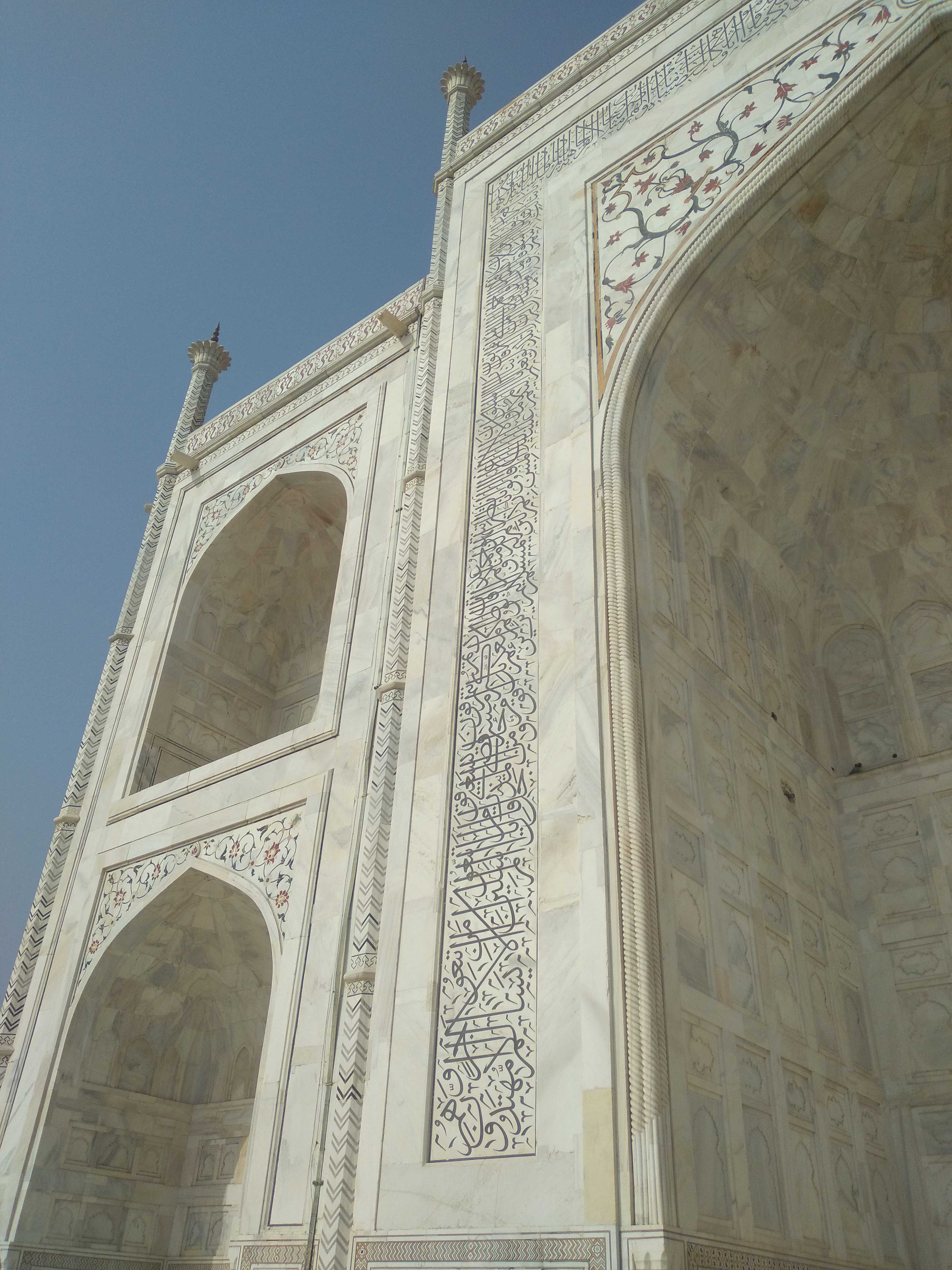
The Taj Mahal’s white marble stunning surfaces and its beautiful details. Source: The author’s personal gallery.
One of the most striking features of the Taj Mahal is its dome, which soars gracefully into the sky, crowned by a finial that seems to touch the heavens. This central dome is surrounded by four smaller domed chhatris, or pavilions, each intricately adorned with delicate carvings and inlaid with precious stones.
The main entrance to the Taj Mahal is through a grand gateway made of red sandstone, which serves as a stark contrast to the gleaming white marble of the main structure. As visitors pass through the gateway and catch their first glimpse of the Taj Mahal, they are greeted by a breathtaking view of the mausoleum reflected in the tranquil waters of a long pool known as the Charbagh.
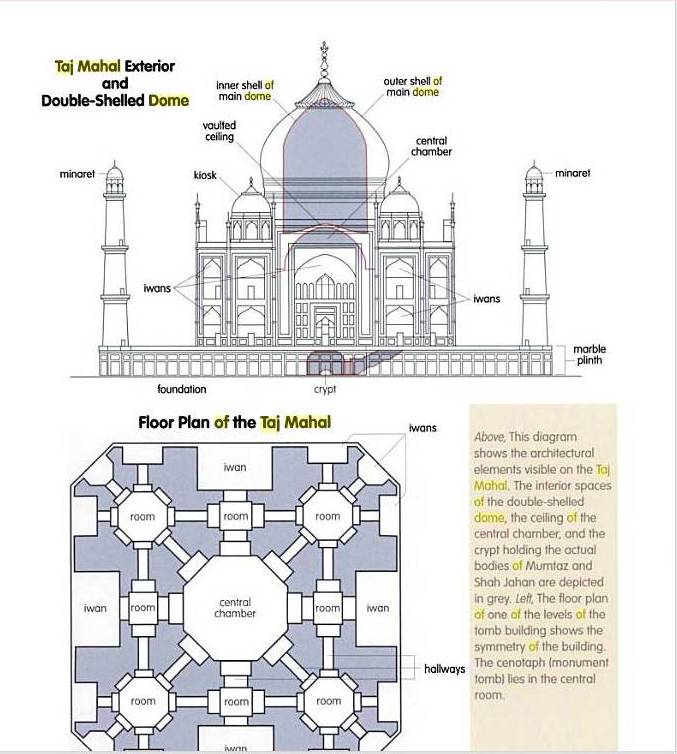
The Taj Mahal’s architectural elements and Floor Plan. Source: https://structureanddesignoftajmahal.blogspot.com/
Symbolism and Symmetry
Beyond its aesthetic beauty, the Taj Mahal is rich in symbolism and meaning. The entire complex is designed to reflect the concept of paradise in Islamic architecture, with the gardens representing the four rivers of paradise and the central mausoleum symbolizing the heavenly throne.
Symmetry plays a crucial role in the design of the Taj Mahal, with every aspect meticulously balanced to create a sense of harmony and order. The four minarets that flank the main structure are not only decorative but also serve a functional purpose, providing stability and support to the central dome.
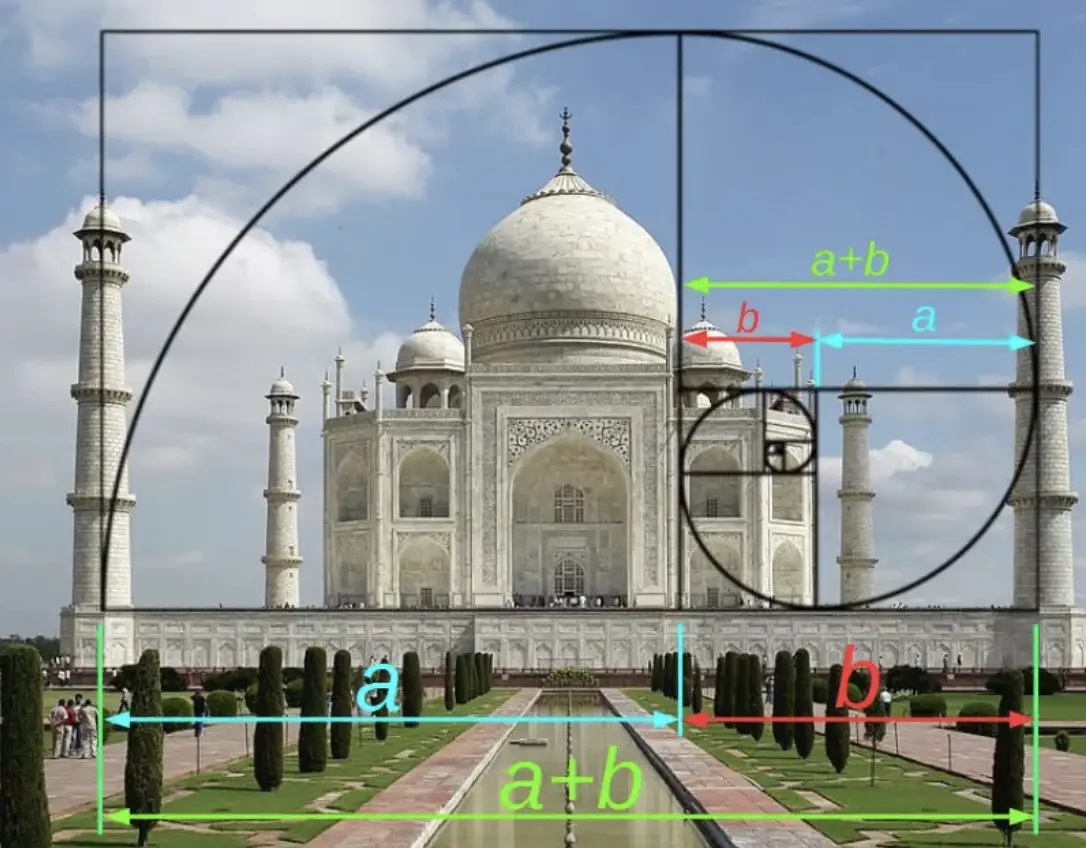
The Golden Ratio applied to the Taj Mahal’s main facade. Source: https://mathsux.org/2018/11/21/the-magic-of-the-golden-ratio/?like_comment=245

The Golden Ratio is also found in nature in many different scales, from galaxies’ configuration to the proportions of human beings, animals and plants. It is considered by some as the divine proportion. Source: https://mytechnofuturemathseasylearn.blogspot.com/p/fibonacci-seriesnumbersequence-god.html
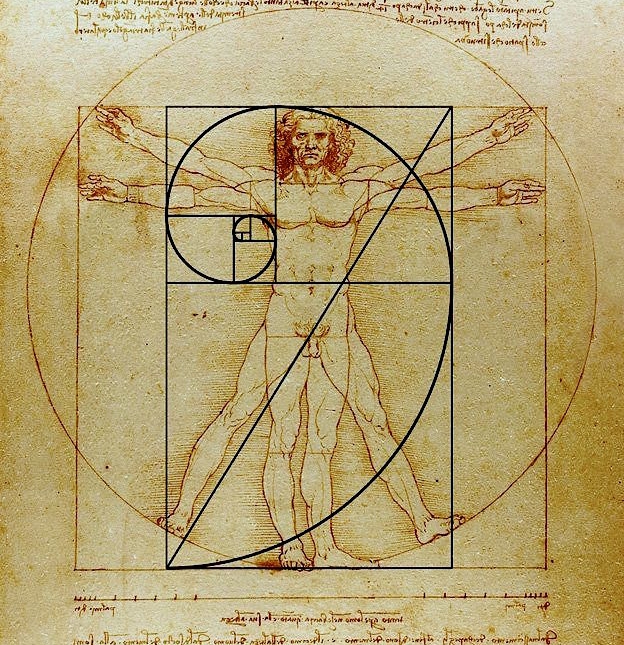
The ‘Vitruvian Man’ by Leonardo Da Vinci showing the Golden Ratio present in the human body proportions. Source: https://laurelberninteriors.com/perfect-architectural-proportions-the-no-fail-formula/
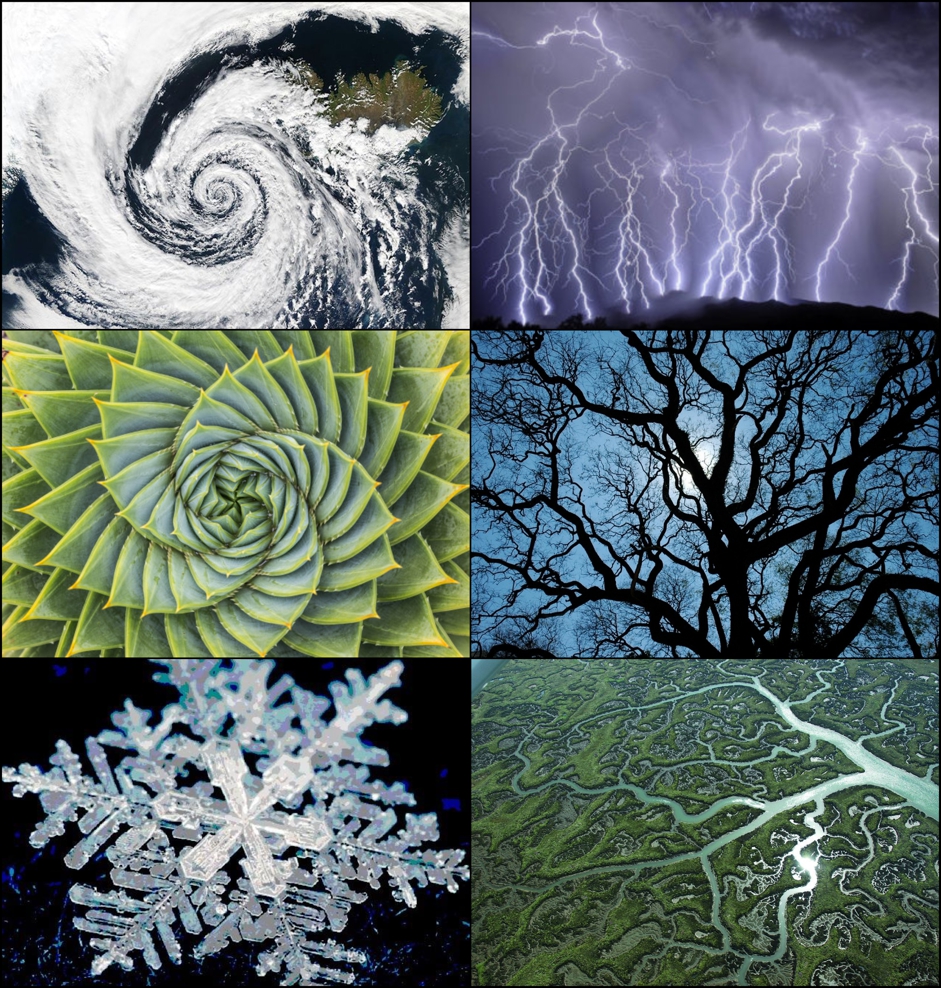
Other patterns found in nature using the golden ratio and how they branch into fractals. Source: https://fractalscience.org/a-aplicacao-da-ciencia-fractal-em-nossas-vidas/

The perfect symmetry of the entire complex is visible to the eye everywhere. View from the main entrance of the monument. Source: The author’s personal gallery.
Intricate Inlay Work
One of the most impressive aspects of the Taj Mahal’s design is its intricate inlay work, known as pietra dura. This technique involves the use of semi-precious stones such as lapis lazuli, jade, and coral to create elaborate floral motifs and calligraphy.
The marble surfaces of the Taj Mahal are adorned with intricate patterns and designs, each carefully crafted by skilled artisans using traditional techniques passed down through generations. The result is a mesmerizing display of craftsmanship and artistry that never fails to captivate visitors.

The Taj Mahal’s carving details. Source: The author’s personal gallery.
Legacy and Influence
Over the centuries, the Taj Mahal has inspired countless artists, architects, and poets with its timeless beauty and elegance. Its influence can be seen in architectural marvels around the world, from the dome of the United States Capitol building to the onion domes of Russian Orthodox churches, buildings definitely designed with a different mindset. Perhaps, the similarities with some of those heritage buildings could point to a part of history that is still not unveiled to the public.
There are mysterious underground chambers in the Taj Mahal that are kept away from the large public, as per some official media news on the internet (‘What secrets do the Taj Mahal’s locked rooms hold?‘). Perhaps those secrets are linked to the undisclosed history of the Taj Mahal, which brings fascination and immense joy to so many people around the world. I really hope one day those mysteries are revealed to the public. In my opinion, it is much more interesting when we face challenges with curiosity and investigative openness than with animosity and rejection.
In conclusion, the Taj Mahal stands as a shining example of architectural excellence and enduring love. From its graceful domes and symmetrical gardens to its intricate inlay work and rich symbolism, every aspect of its design is a testament to the skill and ingenuity of its creators, despite all the conspiracy involving it. As visitors gaze upon its majestic beauty, they are reminded of the timeless power of love, sacred geometry and the enduring legacy of human creativity. ♥
Important Sources:
https://structureanddesignoftajmahal.blogspot.com/
https://talesalongtheway.com/2016/02/27/eyewitness-guides/
https://mathsux.org/2018/11/21/the-magic-of-the-golden-ratio/?like_comment=245
https://www.slideshare.net/AnkitSinha22/taj-mahal-architecture
https://fractalscience.org/a-aplicacao-da-ciencia-fractal-em-nossas-vidas/
Cover image found on:
https://illustrarch.com/articles/16033-the-importance-of-proportion-and-scale.html

















